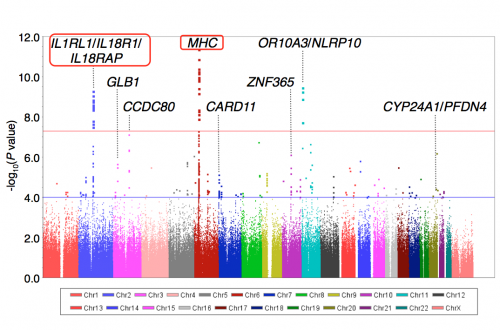Genome-wide study identifies eight new susceptibility loci for atopic dermatitis

Japanese researchers at the RIKEN Center for Genomic Medicine (CGM) and their colleagues have identified 8 new loci associated with susceptibility to atopic dermatitis in the Japanese population. The findings, which appear in the journal Nature Genetics, advance our understanding of the genetic basis of the skin disorder, which affects millions of children and adults around the world.
Atopic dermatitis (often called ecszema) is a chronic, relapsing inflammatory skin condition affecting as much as one-fifth of children and 1-3% of adults in industrialized countries. Those with the condition have skin that reacts easily to the environment and becomes flaky and itchy. While treatment can alleviate some of these symptoms, current techniques remain ineffective in many cases, due in part to a limited scientific understanding of the origins of the condition.
The research group set out to shed light on these origins using a genome-wide association study (GWAS), an approach which identifies gene loci associated with a particular trait. With its strong genetic basis, atopic dermatitis is well suited to the GWAS approach. Three previous GWAS on European and Chinese populations identified 7 loci associated with the condition, but no such studies have been conducted on Japanese people.
To fill this gap, the group conducted a thorough GWAS on 1472 subjects with atopic dermatitis and 7971 controls from among the Japanese population, and then validated their results in a separate study on 1856 subjects with atopic dermatitis and 7021 controls. Analyzing a total of roughly 600,000 genetic variants (called Single Nucleotide Polymorphisms or SNPs), they identified 8 new genetic regions associated with atopic dermatitis and confirmed the 7 loci observed in earlier studies. Among these regions, they identified variants at the IL1RL1/IL18R1/IL18RAP and human leukocyte antigen (HLA) loci, both of which have been associated with bronchial asthma in recent GWAS.
The group's findings thus suggest that atopic dermatitis and asthma have overlapping susceptibility regions, and thus that these regions contain common genetic factors for many allergic diseases. Other loci reveal a wide variety of additional factors possibly involved in the condition, suggesting paths for future research and pointing the way to more effective treatment techniques.
More information: Tomomitsu Hirota, et al. "Genome-wide association study identifies eight new susceptibility loci for atopic dermatitis in the Japanese population." Nature Genetics, 2012, DOI: 10.1038/ng.2438














